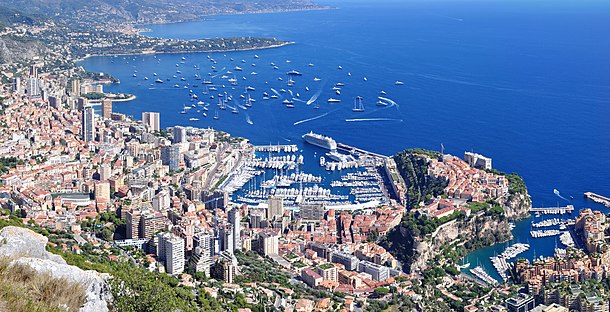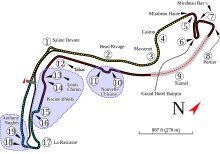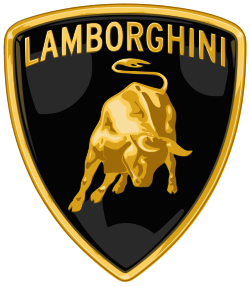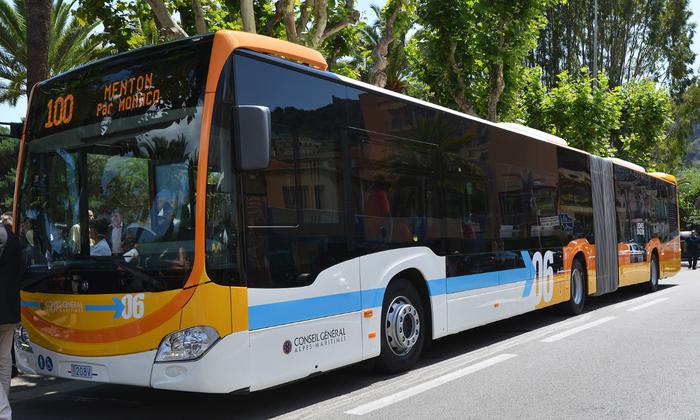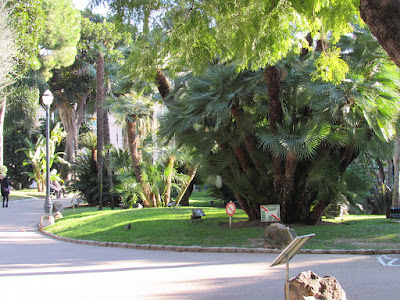
We left Avignon at 10 a.m. on a Saturday morning, 3 days after Christmas when traffic was light. We had no trouble finding our way to the A-7 auto-route, which was a relief after such a harrowing experience two nights before. According to the map we would take the auto-route all the way to Nice for about 3 hours. We would traverse valleys and flat lands rather than the mountains as we neared the Mediterranean Sea to one of the most southeast points of France. Thank goodness!
The silhouettes of the surrounding mountains were very beautiful.
The grapevines for Côte de Provence wines were dormant; sometimes coverings donned their
branches as row upon row of vines graced the rolling plains. Lavender fields, another major French agricultural product, were abundant although not in bloom. Once we parked the car in the underground structure and settled in our hotel, we found that Nice on the French Riveria would offer us many pleasant surprises.
Nice was founded by the Greeks in 350 BC who named it after Nikaia (Nike), the goddess of victory. The Romans took over the city in 154 BC and lived further north up the hill in what is now known as Cimiez. Roman ruins are still there. From the 10th century until 1860, Nice exchanged hands several times between the counts of Provence and the Italian House of Savoy. Finally, in 1860 Emperor Napoleon III signed the Treaty of Turin with the House of Savoy, which made the region French ever since.
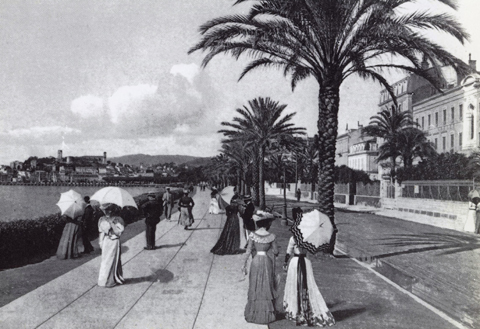
Although the Côte d'Azur or French Riviera was once largely comprised of fishing villages, everything began to change in the late 18th century when the British began coming. At first the warm, dry climate served as an attractive cure for tuberculosis. Then, according to Christian Barker, "the visiting brother of one of these unfortunate souls,
British politician Henry Peter Brougham, First Baron Brougham and
Vaux, took a liking to the spot and chose to rent a villa and stay
on for the season — his friends and admirers followed suit, and the
French Riviera started to grow in popularity as a holiday
destination for hale and hearty, affluent and aristocratic
Brits."
During the second half of the 19th century after a railway line linked Nice with the rest of Europe, the rich and royals came to the area. Hotels and casinos were built to accommodate them. Among those who visited were: Queen Victoria, Tsar Alexander II, Napoleon III, Leopold II, and the Prince of Wales (the future Edward VII).
Longtime Cap Ferrat resident Somerset Maugham, wrote in his autobiographical novel, The Razor’s Edge: “The shores of the Mediterranean were littered with royalties, lured by the climate, or in exile, or escaping a scandalous past or unsuitable marriage.”
Nice was founded by the Greeks in 350 BC who named it after Nikaia (Nike), the goddess of victory. The Romans took over the city in 154 BC and lived further north up the hill in what is now known as Cimiez. Roman ruins are still there. From the 10th century until 1860, Nice exchanged hands several times between the counts of Provence and the Italian House of Savoy. Finally, in 1860 Emperor Napoleon III signed the Treaty of Turin with the House of Savoy, which made the region French ever since.

 |
| The Promenade in the 1930s |
During the second half of the 19th century after a railway line linked Nice with the rest of Europe, the rich and royals came to the area. Hotels and casinos were built to accommodate them. Among those who visited were: Queen Victoria, Tsar Alexander II, Napoleon III, Leopold II, and the Prince of Wales (the future Edward VII).
Longtime Cap Ferrat resident Somerset Maugham, wrote in his autobiographical novel, The Razor’s Edge: “The shores of the Mediterranean were littered with royalties, lured by the climate, or in exile, or escaping a scandalous past or unsuitable marriage.”
 |
| Brigitte Bardot, Circa 1957 |
In 1946, thanks to Brigette Bardot, movie stars began coming to Nice for residence or wintering. People say that the French bombshell and her bikini made the French Riveria what it is today. She had a house in Saint Tropez, a bit west of Nice. Eventually, she left it because it was overrun by gawking movie fans.
Today, Nice is the second-most visited city in France next to Paris.
Niçoise Cityscape
The cityscape of Nice is truly picturesque with its red ochre Italianate buildings, pinky-red tile roofs, and old villas and hotels. The latter were constructed during La Belle Époque (1870-1914), a period of great political and social progress in French society," according to The Culture Trip. These buildings accommodated artists, aristocrats, and royalty during the more moderate winters here.

The architecture of the Belle Époque, was notable for its variety of style, from neo-Byzantine and neo-Gothic to classicism, Art Nouveau and Art Deco. It was also known for its lavish decoration and its imaginative use of both new and traditional materials, including iron, plate glass, colored tile and reinforced concrete. Here are some examples of this beautiful architecture.
Nice has a nice feel to it, and it's a rather jaunty place. Palm trees and subtropical fauna are an obvious difference, as is the sunny and warm weather (50s F) in January and the deep-blue Mediterranean Sea. The centuries-long Italian influence--and proximity--seemed still very present with the number of Italian restaurants as well as in the residents and travelers present. Nice is part of France where the people speak French, but it seemed to me to be more Italian than French. I loved it!
Promenade des Anglais

On our first night we walked toward the seashore to witness the magnificent Baie des Anges (Bay of Angels). It was dark and so we could only hear the waves gently lapping against the shore. We could see, however, the curve of the illuminated coastline. It was a magical experience possibly linked to the spirit of the place told through stories about how the Bay of Angels got its name. Margo Lestz shares three of them on her website, The Good Life France.

 In the mid-19th century as more British aristocracy discovered Nice, the city
soon became a place where the wealthy came to be seen. Creating a promenade (a
walkway) along the coastline, then, seemed like a good idea both for the city and for
the wintering visitors. Reverend Lewis Way and members of the Holy Trinity
Anglican Church funded the project, and poor immigrants who settled in Nice
in 1820 constructed it.
In the mid-19th century as more British aristocracy discovered Nice, the city
soon became a place where the wealthy came to be seen. Creating a promenade (a
walkway) along the coastline, then, seemed like a good idea both for the city and for
the wintering visitors. Reverend Lewis Way and members of the Holy Trinity
Anglican Church funded the project, and poor immigrants who settled in Nice
in 1820 constructed it.
The Promenade
was first called the Camin deis Anglés (the English Way) by the Niçois
in their native dialect. After France annexed Nice in 1860, the Promenade was rechristened
La Promenade des Anglais (Walkway of
the English). The Promenade follows the Mediterranean coastline from the
Nice airport on the west approximately 7 km eastward to the Quai des Étas-Unis. Known to the locals as “La
Prom,” it is popular with bicyclists, skateboarders, baby strollers, and
families, especially on Sundays.
 |
| The French love picnics and find any occasion to have one. |
 One of the biggest surprises along La Prom was that the beach is not sandy. In fact, it was downright rocky to the point that someone walking along the beach makes a lot of noise crossing over the rocks. However, the rocks didn't deter anyone from enjoying some time in the sun for a picnic or a cellphone read. There were even a couple swimmers in waters that measured 55 degrees F.
One of the biggest surprises along La Prom was that the beach is not sandy. In fact, it was downright rocky to the point that someone walking along the beach makes a lot of noise crossing over the rocks. However, the rocks didn't deter anyone from enjoying some time in the sun for a picnic or a cellphone read. There were even a couple swimmers in waters that measured 55 degrees F.
Tracy, my traveling companion, and I couldn't resist posing in front of the beach. The background is the Quai Rauba Capeu where we would see some more astonishing sights.
 The Quai Rauba Capeu provides a dramatic scene. People still generally stroll on La Prom, while others find appealingly fun activities.
The Quai Rauba Capeu provides a dramatic scene. People still generally stroll on La Prom, while others find appealingly fun activities.
A turn around the corner at the Quai Rauba Capeu revealed many natural scenes with cactus plants and more beautiful buildings, some of which seemed to be built within the rocks.
 Place Garibaldi is another gathering place near the Old Port. We discovered it while searching for the "Bus 100" stop that goes every 20 minutes to Monaco. Click here for my post on Monaco.
Place Garibaldi is another gathering place near the Old Port. We discovered it while searching for the "Bus 100" stop that goes every 20 minutes to Monaco. Click here for my post on Monaco. The square was built at the end of the 18th century and served as the entry gate to the city and the way leading to Turin. The recent rebuilding of the area to accommodate
the new tramway line designated most of the entire square to pedestrians.
The square was built at the end of the 18th century and served as the entry gate to the city and the way leading to Turin. The recent rebuilding of the area to accommodate
the new tramway line designated most of the entire square to pedestrians.
The architecture uses the Turin model, which was the norm of
urban renewal throughout the entire realm of the House of Savoy in its day.
 Another sign of Italian influence is the statue of Giuseppe Garibaldi in the square named after him. He was an Italian general and patriot who contributed to Italian unification and the creation of the Kingdom of Italy. He was fiercely opposed to the union of Nice with France.
Another sign of Italian influence is the statue of Giuseppe Garibaldi in the square named after him. He was an Italian general and patriot who contributed to Italian unification and the creation of the Kingdom of Italy. He was fiercely opposed to the union of Nice with France.
We celebrated all our discoveries that afternoon with some tea and patissierie in Place Garibaldi.
I Love Nice
 |
| our table serving |
After our afternoon tea, we made our way along Avenue Jean Médecin, one of the main arteries of the city. Shops galore line the street as trams, cars, motorcycles, and scooters whiz by. There were a lot of people out on this holiday evening, but not as many as there would be in the summer months. We happily discovered that our hotel was only a couple blocks away, the Mediterranean Sea was at the end of the street, and Old Nice was around the corner. What a perfect location for us!
 |
| Small fountains spurt upward into a shallow pool with the carnival in the background |
 In the evening
we walked to Place Masséna, the main square of the city where there was a garden, a Ferris wheel and carnival, and lights projected onto the buildings. I posed before "I Love Nice" sign,
but could only capture a silhouette.
In the evening
we walked to Place Masséna, the main square of the city where there was a garden, a Ferris wheel and carnival, and lights projected onto the buildings. I posed before "I Love Nice" sign,
but could only capture a silhouette.
Neptune, Roman god of the sea, overlooks Place Masséna. The Place has typically been the spot for great public events like concerts, summer festivals, the Corso carnavalesque
(carnival parade) in February, the military procession of Bastille Day, and other traditional celebrations and banquets.
 Our favorite dinner spot was the L’Opera Bistro. One salad I ordered came with a burrata mozzarella ball,
which has a
crusty outer shell and soft, runny cheese on the interior. I also had mushroom risotto,
which I chose in remembrance of my recently-deceased Aunt Frances on the day
of her memorial service. She regarded risotto as a special dish--and she loved opera, too. We liked this restaurant so much, we went back for another meal on our last night in the city.
Our favorite dinner spot was the L’Opera Bistro. One salad I ordered came with a burrata mozzarella ball,
which has a
crusty outer shell and soft, runny cheese on the interior. I also had mushroom risotto,
which I chose in remembrance of my recently-deceased Aunt Frances on the day
of her memorial service. She regarded risotto as a special dish--and she loved opera, too. We liked this restaurant so much, we went back for another meal on our last night in the city.
 Our favorite dinner spot was the L’Opera Bistro. One salad I ordered came with a burrata mozzarella ball,
which has a
crusty outer shell and soft, runny cheese on the interior. I also had mushroom risotto,
which I chose in remembrance of my recently-deceased Aunt Frances on the day
of her memorial service. She regarded risotto as a special dish--and she loved opera, too. We liked this restaurant so much, we went back for another meal on our last night in the city.
Our favorite dinner spot was the L’Opera Bistro. One salad I ordered came with a burrata mozzarella ball,
which has a
crusty outer shell and soft, runny cheese on the interior. I also had mushroom risotto,
which I chose in remembrance of my recently-deceased Aunt Frances on the day
of her memorial service. She regarded risotto as a special dish--and she loved opera, too. We liked this restaurant so much, we went back for another meal on our last night in the city. The decoration of the restaurant is as appealing for the eyes as the food is for the mouth.
Nice helped me realize that I have never felt more comfortable with myself since I came to live in France two years ago. The food, the language, the music, the history, the architecture, the landscapes, and the French concept of “le bonheur” suit me and have opened an unexpected door for my new life in the Old World. Nice has been like icing on a cake in this adventure.


























